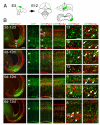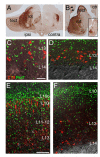Regulation of the development of tectal neurons and their projections by transcription factors Brn3a and Pax7
- PMID: 18280463
- PMCID: PMC2396191
- DOI: 10.1016/j.ydbio.2007.12.040
Regulation of the development of tectal neurons and their projections by transcription factors Brn3a and Pax7
Abstract
The rostral part of the dorsal midbrain, known as the superior colliculus in mammals or the optic tectum in birds, receives a substantial retinal input and plays a diverse and important role in sensorimotor integration. However, little is known about the development of specific subtypes of neurons in the tectum, particularly those which contribute tectofugal projections to the thalamus, isthmic region, and hindbrain. Here we show that two homeodomain transcription factors, Brn3a and Pax7, are expressed in mutually exclusive patterns in the developing and mature avian midbrain. Neurons expressing these factors are generated at characteristic developmental times, and have specific laminar fates within the tectum. In mice expressing betagalactosidase targeted to the Pou4f1 (Brn3a) locus, Brn3a-expressing neurons contribute to the ipsilateral but not the contralateral tectofugal projections to the hindbrain. Using misexpression of Brn3a and Pax7 by electroporation in the chick tectum, combined with GFP reporters, we show that Brn3a determines the laminar fate of subsets of tectal neurons. Furthermore, Brn3a regulates the development of neurons contributing to specific ascending and descending tectofugal pathways, while Pax7 globally represses the development of tectofugal projections to nearly all brain structures.
Figures








Similar articles
-
Signals from the ventral midline and isthmus regulate the development of Brn3.0-expressing neurons in the midbrain.Mech Dev. 2001 Jul;105(1-2):129-44. doi: 10.1016/s0925-4773(01)00399-9. Mech Dev. 2001. PMID: 11429288
-
Brn3a and Nurr1 mediate a gene regulatory pathway for habenula development.J Neurosci. 2009 Nov 11;29(45):14309-22. doi: 10.1523/JNEUROSCI.2430-09.2009. J Neurosci. 2009. PMID: 19906978 Free PMC article.
-
A multiphasic role for Pax7 in tectal development.Exp Brain Res. 2006 Feb;169(2):266-71. doi: 10.1007/s00221-005-0335-0. Epub 2006 Jan 21. Exp Brain Res. 2006. PMID: 16429269
-
[Molecular mechanism of the formation and rostrocaudal polarity of the optic tectum].Kaibogaku Zasshi. 1999 Jun;74(3):327-34. Kaibogaku Zasshi. 1999. PMID: 10429377 Review. Japanese.
-
The role of Pax7 in determining the cytoarchitecture of the superior colliculus.Dev Growth Differ. 2004 Jun;46(3):213-8. doi: 10.1111/j.1440-169x.2004.00744.x. Dev Growth Differ. 2004. PMID: 15206952 Review.
Cited by
-
Pax7 is requisite for maintenance of a subpopulation of superior collicular neurons and shows a diverging expression pattern to Pax3 during superior collicular development.BMC Dev Biol. 2008 May 30;8:62. doi: 10.1186/1471-213X-8-62. BMC Dev Biol. 2008. PMID: 18513381 Free PMC article.
-
A novel role for FOXA2 and SHH in organizing midbrain signaling centers.Dev Biol. 2012 Sep 1;369(1):32-42. doi: 10.1016/j.ydbio.2012.06.018. Epub 2012 Jun 27. Dev Biol. 2012. PMID: 22750257 Free PMC article.
-
Gata2 is required for migration and differentiation of retinorecipient neurons in the superior colliculus.J Neurosci. 2011 Mar 23;31(12):4444-55. doi: 10.1523/JNEUROSCI.4616-10.2011. J Neurosci. 2011. PMID: 21430145 Free PMC article.
-
Laf4/Aff3, a gene involved in intellectual disability, is required for cellular migration in the mouse cerebral cortex.PLoS One. 2014 Aug 27;9(8):e105933. doi: 10.1371/journal.pone.0105933. eCollection 2014. PLoS One. 2014. PMID: 25162227 Free PMC article.
-
Red nucleus and rubrospinal tract disorganization in the absence of Pou4f1.Front Neuroanat. 2015 Feb 5;9:8. doi: 10.3389/fnana.2015.00008. eCollection 2015. Front Neuroanat. 2015. PMID: 25698939 Free PMC article.
References
-
- Agarwala S, Sanders TA, Ragsdale CW. Sonic hedgehog control of size and shape in midbrain pattern formation. Science. 2001;291:2147–50. - PubMed
-
- Bayly RD, Ngo M, Aglyamova GV, Agarwala S. Regulation of ventral midbrain patterning by Hedgehog signaling. Development. 2007;134:2115–2124. - PubMed
-
- Benowitz LI, Karten HJ. Organization of the tectofugal visual pathway in the pigeon: a retrograde transport study. J Comp Neurol. 1976;167:503–20. - PubMed
-
- Blaess S, Corrales JD, Joyner AL. Sonic hedgehog regulates Gli activator and repressor functions with spatial and temporal precision in the mid/hindbrain region. Development. 2006;133:1799–809. - PubMed
-
- Crossley PH, Martinez S, Martin GR. Midbrain development induced by FGF8 in the chick embryo. Nature. 1996;380:66–8. - PubMed
Publication types
MeSH terms
Substances
Grants and funding
LinkOut - more resources
Full Text Sources
Molecular Biology Databases

